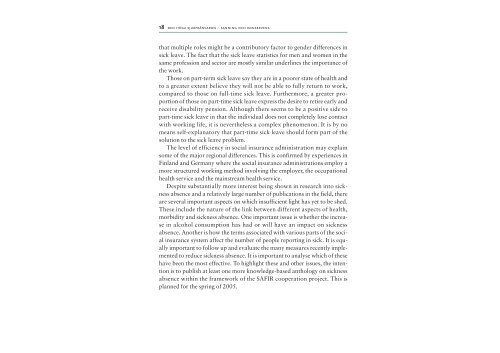Den höga sjukfrånvaron - Statens folkhälsoinstitut
Den höga sjukfrånvaron - Statens folkhälsoinstitut
Den höga sjukfrånvaron - Statens folkhälsoinstitut
You also want an ePaper? Increase the reach of your titles
YUMPU automatically turns print PDFs into web optimized ePapers that Google loves.
18 den <strong>höga</strong> <strong>sjukfrånvaron</strong> – sanning och konsekvens<br />
that multiple roles might be a contributory factor to gender differences in<br />
sick leave. The fact that the sick leave statistics for men and women in the<br />
same profession and sector are mostly similar underlines the importance of<br />
the work.<br />
Those on part-term sick leave say they are in a poorer state of health and<br />
to a greater extent believe they will not be able to fully return to work,<br />
compared to those on full-time sick leave. Furthermore, a greater proportion<br />
of those on part-time sick leave express the desire to retire early and<br />
receive disability pension. Although there seems to be a positive side to<br />
part-time sick leave in that the individual does not completely lose contact<br />
with working life, it is nevertheless a complex phenomenon. It is by no<br />
means self-explanatory that part-time sick leave should form part of the<br />
solution to the sick leave problem.<br />
The level of efficiency in social insurance administration may explain<br />
some of the major regional differences. This is confirmed by experiences in<br />
Finland and Germany where the social insurance administrations employ a<br />
more structured working method involving the employer, the occupational<br />
health service and the mainstream health service.<br />
Despite substantially more interest being shown in research into sickness<br />
absence and a relatively large number of publications in the field, there<br />
are several important aspects on which insufficient light has yet to be shed.<br />
These include the nature of the link between different aspects of health,<br />
morbidity and sickness absence. One important issue is whether the increase<br />
in alcohol consumption has had or will have an impact on sickness<br />
absence. Another is how the terms associated with various parts of the social<br />
insurance system affect the number of people reporting in sick. It is equally<br />
important to follow up and evaluate the many measures recently implemented<br />
to reduce sickness absence. It is important to analyse which of these<br />
have been the most effective. To highlight these and other issues, the intention<br />
is to publish at least one more knowledge-based anthology on sickness<br />
absence within the framework of the SAFIR cooperation project. This is<br />
planned for the spring of 2005.

















